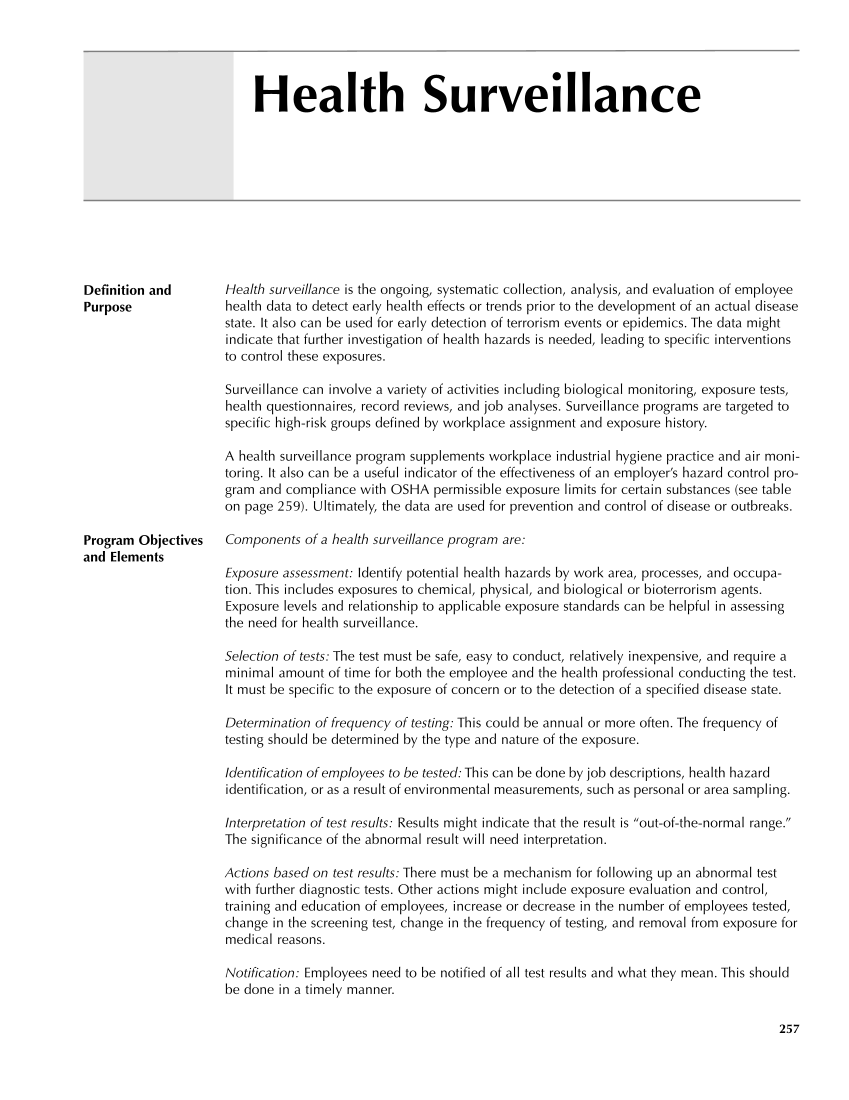Health surveillance is the ongoing, systematic collection, analysis, and evaluation of employee health data to detect early health effects or trends prior to the development of an actual disease state. It also can be used for early detection of terrorism events or epidemics. The data might indicate that further investigation of health hazards is needed, leading to specific interventions to control these exposures. Surveillance can involve a variety of activities including biological monitoring, exposure tests, health questionnaires, record reviews, and job analyses. Surveillance programs are targeted to specific high-risk groups defined by workplace assignment and exposure history. A health surveillance program supplements workplace industrial hygiene practice and air moni- toring. It also can be a useful indicator of the effectiveness of an employer’s hazard control pro- gram and compliance with OSHA permissible exposure limits for certain substances (see table on page 259). Ultimately, the data are used for prevention and control of disease or outbreaks. Components of a health surveillance program are: Exposure assessment: Identify potential health hazards by work area, processes, and occupa- tion. This includes exposures to chemical, physical, and biological or bioterrorism agents. Exposure levels and relationship to applicable exposure standards can be helpful in assessing the need for health surveillance. Selection of tests: The test must be safe, easy to conduct, relatively inexpensive, and require a minimal amount of time for both the employee and the health professional conducting the test. It must be specific to the exposure of concern or to the detection of a specified disease state. Determination of frequency of testing: This could be annual or more often. The frequency of testing should be determined by the type and nature of the exposure. Identification of employees to be tested: This can be done by job descriptions, health hazard identification, or as a result of environmental measurements, such as personal or area sampling. Interpretation of test results: Results might indicate that the result is “out-of-the-normal range.” The significance of the abnormal result will need interpretation. Actions based on test results: There must be a mechanism for following up an abnormal test with further diagnostic tests. Other actions might include exposure evaluation and control, training and education of employees, increase or decrease in the number of employees tested, change in the screening test, change in the frequency of testing, and removal from exposure for medical reasons. Notification: Employees need to be notified of all test results and what they mean. This should be done in a timely manner. 257 Definition and Purpose Program Objectives and Elements Health Surveillance
Purchased from OEM Press by (ge corporate access). (C) 2013 OEM Health Information, Inc. All rights reserved.












































































































































































































































































































































































































































